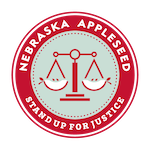Note: For Foster Care Awareness Month in May, we are releasing a series of podcasts hosted by Appleseed intern Victory Klafter built on fantastic interviews with incredible Nebraskans who have been involved with the child welfare or juvenile justice system, with a focus on foster care and Lesbian, Gay, Bisexual, and/or Transgender people.
In the middle of the series we’ll feature a guest blog post from our newest child welfare intern and then cap it off with a long-form episode compiling the three segments together with some extra discussion and analysis.
Look for important links in the accompanying blog posts with each episode to look further into the data. Leave comments to let us know what you think of the interviews. And share, share, share!
Episode 1 – Nathan Collier and Michelle Lueder

According to the Nebraska Office of the Inspector General of Child Welfare’s 2017 report, 1,284 children were involved in substantiated cases of sexual abuse between 2013 and 2016.
The OIG report summarizes the cases of 50 child victims of sexual abuse who were in foster care or who had an open child welfare file when the abuse began. However, we expect that the instances of sexual abuse exceed the number that is reported, as is true for most sexual violence. Sexual abuse in foster care is expected to match this pattern since “studies suggest that youth in these systems [child welfare and juvenile justice] are particularly vulnerable to sexual abuse and exploitation.”
In the United States, research estimates that youth living without either parent (including foster care or a residential facility) are 10 times more likely to be sexually abused than youth living with both parents.” (Sedlak, A.J., et al. Fourth National Incidence Study of Child Abuse and Neglect (NIS–4): Report to Congress.. Washington, DC: U.S. Department of Health and Human Services, Administration for Children and Families. 2010.)
Twenty-seven of the 50 substantiated cases were of children in state-care and 23 were children who had been in the foster care system but had been placed in permanent homes before the abuse started.
In the juvenile justice sphere there’s more startling statistics: at least 80 percent of youth age 13-18 in out of home care were on probation in 2016.
And when Nebraskan youth went through the court system, 67 percent in juvenile court had access to legal representation, while only 34 percent in criminal court had access to legal representation. It’s likely that youth who were in foster care and were being tried in criminal court had even less access to legal representation, although it has not yet been recorded.
On this week’s installation of our Foster Care Awareness month podcast, Nathan Collier and Michele Lueders share their perspectives on these issues in the foster care and juvenile justice system that all too often overlap.
Trigger Warning: This podcast includes discussion of an incident of sexual abuse at the 5:00 mark.
